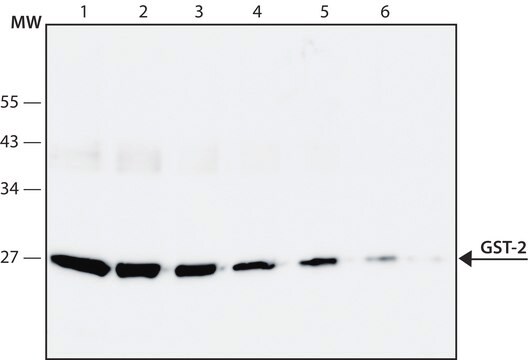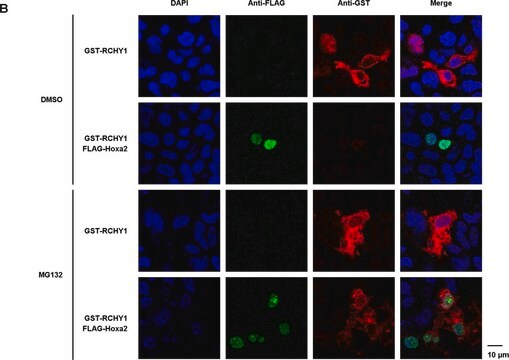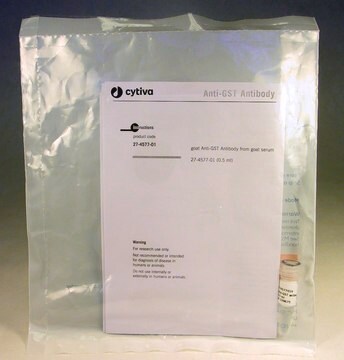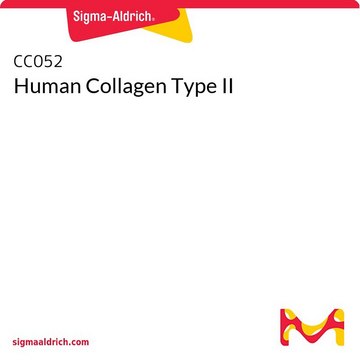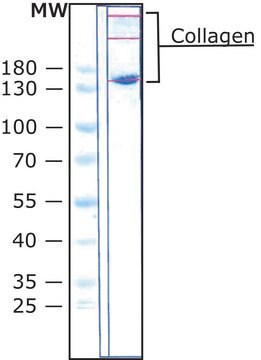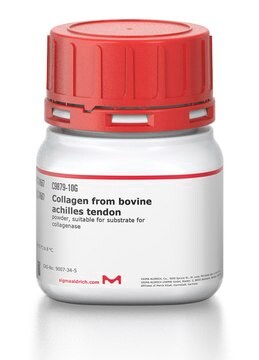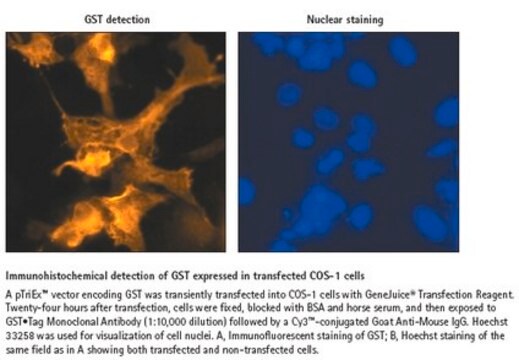G1160
Monoclonal Anti-Glutathione-S-Transferase (GST) antibody produced in mouse
clone GST-2, ascites fluid
Synonym(s):
Mouse Anti-GST Tag
Sign Into View Organizational & Contract Pricing
All Photos(4)
About This Item
Recommended Products
biological source
mouse
Quality Level
conjugate
unconjugated
antibody form
ascites fluid
antibody product type
primary antibodies
clone
GST-2, monoclonal
contains
15 mM sodium azide
technique(s)
dot blot: suitable
indirect ELISA: suitable
western blot: 1:1,000 using purified recombinant GST or lysate of induced bacteria expressing recombinant GST
isotype
IgG2b
shipped in
dry ice
storage temp.
−20°C
target post-translational modification
unmodified
General description
Monoclonal anti-glutathione-S-transferase (GST) (mouse IgG2b isotype) is derived from the GST-2 hybridoma produced by the fusion of mouse myeloma cells and splenocytes from a BALB/c mouse immunized with a purified recombinant GST fusion protein.GST belongs to three family of proteins distinguished as cytosolic, mitochondrial and microsomal GST. At present, eight distinct classes of the soluble cytoplasmic mammalian glutathione S-transferases have been identified: α, κ, μ, ω, σ, θ, π and ζ.
Recombinant target proteins are often expressed as a fusion product with Glutathione-S-Transferase (GST) tags using various expression vector constructs. Thus, antibodies directed against the GST tags of the recombinant constructs can facilitate the purification and study of target proteins. Monoclonal Anti-Glutathione-S-Transferase (GST) antibody reacts with GST from Schistosoma japonicum. Furthermore, the product identifies native as well as denatured-reduced forms of purified GST and GST fusion proteins. The antibody does not detect GST derived from rat, rabbit, porcine and bovine liver or from human placenta.
Immunogen
recombinant Glutathione-S-Transferase (GST) fusion protein.
Application
Monoclonal Anti-Glutathione-S-Transferase (GST) antibody has been used for use in western blot and ELISA. This product has also been used for dot blot.
Biochem/physiol Actions
Glutathione S-transferases (GSTs) are a family of enzymes that play an important role in detoxification by catalyzing the conjugation of many hydrophobic and electrophilic compounds with reduced glutathione.
Disclaimer
Unless otherwise stated in our catalog or other company documentation accompanying the product(s), our products are intended for research use only and are not to be used for any other purpose, which includes but is not limited to, unauthorized commercial uses, in vitro diagnostic uses, ex vivo or in vivo therapeutic uses or any type of consumption or application to humans or animals.
Not finding the right product?
Try our Product Selector Tool.
recommended
Product No.
Description
Pricing
Storage Class Code
12 - Non Combustible Liquids
WGK
nwg
Flash Point(F)
Not applicable
Flash Point(C)
Not applicable
Choose from one of the most recent versions:
Already Own This Product?
Find documentation for the products that you have recently purchased in the Document Library.
Customers Also Viewed
Young C Shin et al.
Cancer research, 68(6), 1751-1759 (2008-03-15)
Kaposi's sarcoma-associated herpesvirus (KSHV) is the etiologic agent associated with Kaposi's sarcoma, primary effusion lymphoma, and multicentric Castleman's disease. Hypoxia-inducible factor-1 (HIF-1) is the master regulator of both developmental and pathologic angiogenesis, composed of an oxygen-sensitive alpha-subunit and a constitutively
Björn Titz et al.
Journal of bacteriology, 188(21), 7700-7706 (2006-08-29)
TP0658 (FliW) and its orthologs, conserved proteins of unknown function in Treponema pallidum and other species, interact with a C-terminal region of flagellin (FlaB1-3 in T. pallidum; FliC in most other species). Mutants of orthologs in Bacillus subtilis and Campylobacter
Daniel Spazierer et al.
Journal of cell science, 121(Pt 6), 825-833 (2008-02-21)
Epiplakin is a large (>725 kDa) cytoskeletal protein exclusively expressed in epithelial tissues. It has a unique structure, consisting entirely of plakin repeat domains (PRDs), one of the hallmarks of spectraplakin protein family members. Previous studies, including the phenotypic analyses
Structure, function and evolution of glutathione transferases: implications for classification of non-mammalian members of an ancient enzyme superfamily.
Sheehan D, et al.
The Biochemical Journal, 360(1), 1-16 (2001)
Anna Brotcke et al.
Infection and immunity, 76(8), 3473-3480 (2008-06-19)
Francisella tularensis infects wild animals and humans to cause tularemia. This pathogen targets the cytosol of macrophages, where it replicates using the genes in the Francisella pathogenicity island (FPI). Virulence gene regulation in Francisella is complex, but transcriptional regulators MglA
Our team of scientists has experience in all areas of research including Life Science, Material Science, Chemical Synthesis, Chromatography, Analytical and many others.
Contact Technical Service